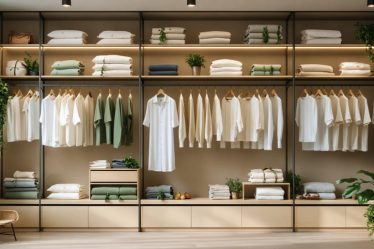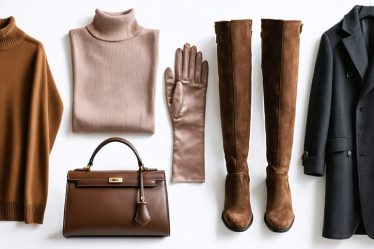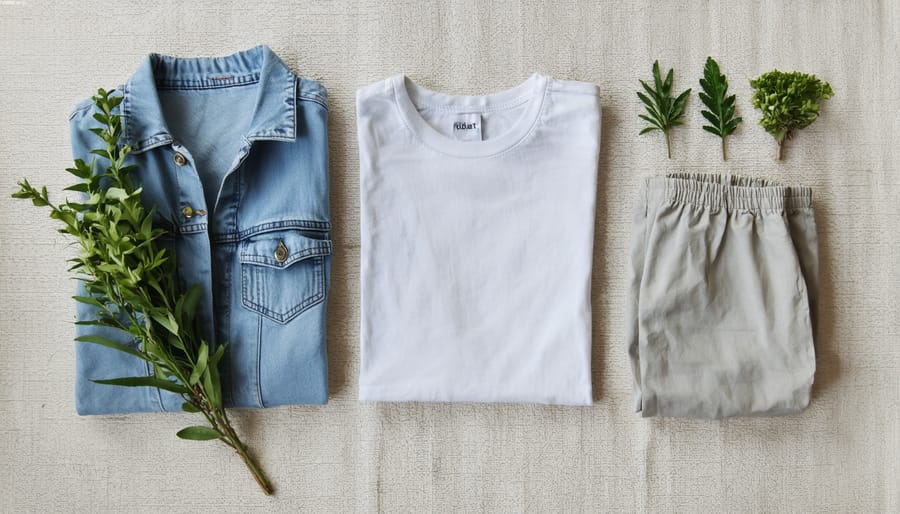
Transform your wardrobe into a sustainable fashion powerhouse by choosing timeless, high-quality pieces crafted from organic cotton, hemp, and recycled materials. The shift toward eco-friendly fashion isn’t just a trend—it’s a powerful movement reshaping how we express ourselves through clothing while protecting our planet.
Gone are the days when sustainable style meant compromising on aesthetics. Today’s conscious fashion combines cutting-edge design with environmental responsibility, offering everything from sleek workwear to casual weekend essentials. By investing in versatile, ethically-made pieces and embracing circular fashion practices like clothing rentals and swaps, you’re not just building a wardrobe—you’re participating in a global shift toward mindful consumption.
Whether you’re just starting your sustainable fashion journey or looking to deepen your commitment to ethical style, the key lies in making informed choices that align with both your personal aesthetic and environmental values. This comprehensive guide will show you how to curate a sustainable wardrobe that’s as kind to the planet as it is to your style sensibilities.
Building a Sustainable Wardrobe Without Sacrificing Style
Quality Over Quantity: Investment Pieces That Last
When it comes to building a versatile wardrobe, I’ve learned that investing in fewer, higher-quality pieces ultimately serves both our planet and our closets better. Think of it this way: that $30 trendy top might seem like a bargain, but if it loses shape after three washes, you’ll end up spending more replacing it throughout the year.
Instead, consider investing in timeless pieces that stand the test of time. A well-made wool coat, perfectly fitted jeans, or a classic silk blouse might cost more initially, but these pieces can last for years with proper care. I still wear a cashmere sweater I invested in five years ago, and it looks as beautiful as the day I bought it.
Look for telltale signs of quality: natural fibers, sturdy stitching, and thoughtful details like lined garments and finished seams. These elements not only ensure longevity but also provide better comfort and fit. When shopping, I always check the care label and construction – if a garment feels flimsy or has loose threads before purchase, it’s likely to disappoint later.
Remember, quality pieces don’t always mean luxury price tags. Many mid-range brands now offer well-made basics that can serve as the foundation of your sustainable wardrobe. The key is to choose items that align with your personal style rather than chasing fleeting trends. This approach not only reduces waste but also helps you develop a signature look that truly reflects who you are.
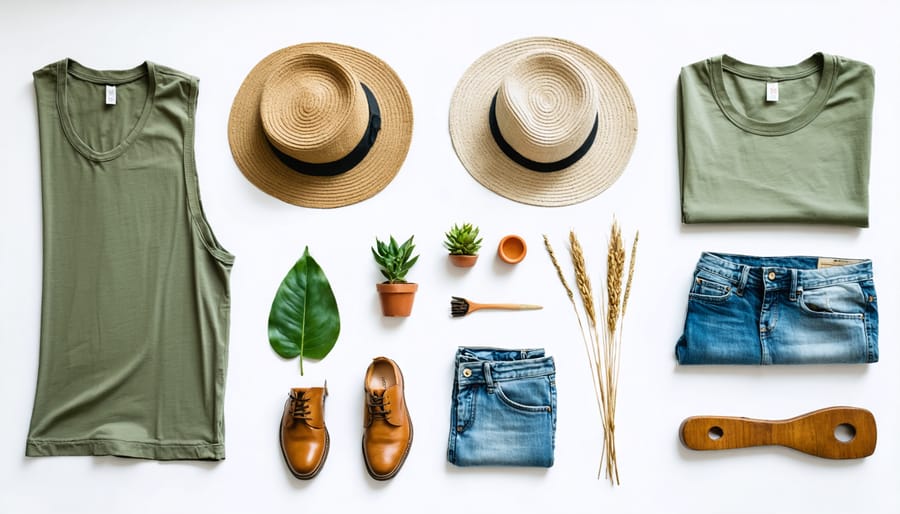
Sustainable Fabrics: What to Look For
When I first started exploring sustainable fashion, the fabric choices seemed overwhelming, but I’ve learned that identifying eco-friendly materials isn’t as complicated as it might seem. Natural fibers like organic cotton, hemp, and linen are excellent starting points – they’re biodegradable and typically require fewer chemicals to produce than conventional alternatives.
Look for GOTS (Global Organic Textile Standard) certification on cotton items, which ensures both environmental and social responsibility in production. Tencel and Modal, made from wood pulp cellulose, are innovative alternatives that use less water and chemicals than traditional materials. These fabrics feel incredibly soft and drape beautifully, making them perfect for everything from casual wear to workwear.
Recycled materials are another game-changer in sustainable fashion. Keep an eye out for recycled polyester (often made from plastic bottles) and recycled cotton. While shopping, check the label for specific percentages of recycled content – the higher, the better.
Some lesser-known but equally sustainable options include bamboo (which grows quickly with minimal resources), peace silk (produced without harming silkworms), and wool from certified responsible sources. Remember that blended fabrics can be sustainable too, especially when they combine natural and recycled materials to create durable, long-lasting pieces.
Pro tip: Many sustainable brands now include detailed material information on their websites or garment tags, making it easier to make informed choices.
Care Techniques That Extend Garment Life
Washing and Drying for Longevity
Taking care of your sustainable fashion pieces is just as important as choosing them in the first place. I learned this lesson the hard way after shrinking my favorite organic cotton sweater – a mistake I now help others avoid! Let’s talk about how to keep your eco-friendly wardrobe looking fresh while minimizing environmental impact.
Start by washing your clothes less frequently. Many items, especially denim and sweaters, don’t need washing after every wear. Simply air them out between uses and spot clean when necessary. When you do wash, opt for cold water whenever possible – it’s gentler on fabrics and uses less energy.
Choose eco-friendly detergents that are phosphate-free and biodegradable. I’ve found that concentrated formulas work wonderfully while reducing packaging waste. For delicate items, try handwashing with gentle soap nuts or castile soap – your clothes will thank you with extended longevity.
When it comes to drying, embrace the power of air-drying! Hang your clothes on a drying rack or clothesline when weather permits. This method not only saves energy but also prevents the fiber damage and shrinkage that often occurs in dryers. If you must use a dryer, opt for the lowest heat setting and remove items while slightly damp to reduce wrinkles naturally.
For those tricky stains, try natural solutions first. A mixture of white vinegar and baking soda can work wonders on most spots. Remember to always test any cleaning solution on a small, hidden area first.
These mindful washing practices not only extend the life of your sustainable wardrobe but also reduce your environmental footprint – a win-win for both your closet and the planet!
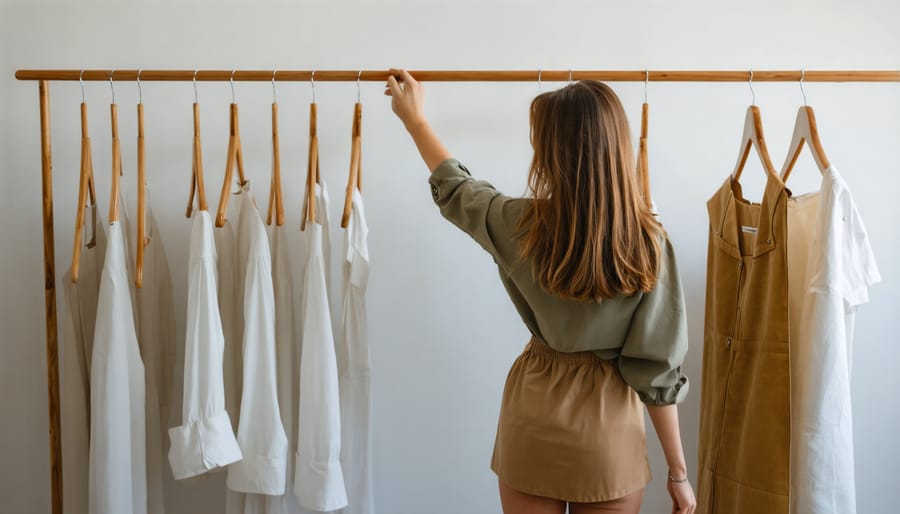
Storage Solutions That Protect
You know that feeling when you pull out your favorite sweater only to find it’s lost its shape or developed unwanted holes? Proper storage is just as crucial as mindful purchasing when it comes to sustainable fashion. Let me share some game-changing storage solutions that will help your beloved pieces stand the test of time.
First, invest in breathable garment bags for delicate items like silk dresses and wool coats. I learned this the hard way after storing my grandmother’s vintage blazer in plastic, only to discover moisture damage months later. Natural fabric bags allow air circulation while protecting from dust and moths.
For knits and sweaters, always fold rather than hang to prevent shoulder stretching. I like to layer acid-free tissue paper between folds to prevent creasing. Store these items in drawers or on shelves, away from direct sunlight which can fade and weaken fibers.
When it comes to hangers, wooden or padded options are worth the investment. Wire hangers are budget-friendly, but they can create permanent dimples in shoulders and distort garment shapes. For pants and skirts, opt for clip hangers with rubber-coated grips to prevent marking.
Create a seasonal rotation system to maximize space and minimize wear. I use vacuum storage bags for off-season items, but remember to clean everything thoroughly before storing – even tiny spots can attract moths or develop into permanent stains over time.
Don’t forget about shoes! Use shoe trees for leather footwear to maintain shape, and store in their original boxes or clear containers with air holes. A little extra care in storage today means your sustainable fashion choices will look beautiful for years to come.
Sustainable Shopping Strategies
Thrifting and Second-Hand Shopping
Thrifting has become my absolute favorite way to build a sustainable wardrobe, and I’m excited to share some insider tips for finding those hidden gems! Whether you’re shopping on a budget or simply looking to reduce your fashion footprint, second-hand shopping offers endless possibilities.
Start by familiarizing yourself with quality markers: check seams for sturdy stitching, examine fabric content labels, and look for well-known brands known for durability. I’ve found some of my most treasured pieces – including a perfectly tailored wool blazer – by focusing on these details.
Timing is everything in thrifting. Visit stores on weekday mornings when they’re less crowded and newly stocked. Many shops receive donations throughout the week and refresh their inventory regularly. Consider exploring thrift stores in upscale neighborhoods, which often yield higher-end pieces.
Don’t forget about online thrifting platforms! Sites like ThredUp, Poshmark, and Depop have revolutionized second-hand shopping. Pro tip: save searches for specific brands or items you’re hunting for, and set up alerts for when they become available.
Before making a purchase, always check for any damage or wear that can’t be easily fixed. Small repairs like replacing buttons or fixing a hem are worth it for quality pieces, but be realistic about what you’re willing to tackle.
Remember, building a sustainable wardrobe through thrifting takes patience and persistence, but the thrill of finding that perfect piece at a fraction of its original cost (and environmental impact) makes it all worthwhile!
Identifying Truly Sustainable Brands
With so many brands claiming to be sustainable these days, it can feel overwhelming to separate genuine eco-friendly efforts from clever marketing. I learned this firsthand when I fell for a “green-washed” collection last year, which taught me the importance of doing proper research.
To identify truly sustainable brands, start by looking beyond the buzzwords. Check if the brand provides transparent information about their manufacturing processes, material sourcing, and worker conditions. Legitimate sustainable brands typically share detailed information about their supply chain and environmental initiatives on their websites.
Look for recognized certifications like GOTS (Global Organic Textile Standard), Fair Trade, or B Corp certification. These third-party verifications require brands to meet strict environmental and social standards. Also, pay attention to the materials used – sustainable brands often use organic, recycled, or innovative eco-friendly fabrics and clearly explain their environmental impact.
Another telling sign is how a brand approaches production. Sustainable fashion companies usually produce in smaller batches to avoid excess inventory and often operate on a made-to-order or pre-order basis. They’re also typically open about their sustainability challenges and areas for improvement, rather than making sweeping claims of being 100% sustainable.
Don’t forget to check their social media and customer reviews for real experiences and to see how they engage with questions about their sustainability practices. A truly sustainable brand will welcome transparency and honest dialogue about their environmental efforts.
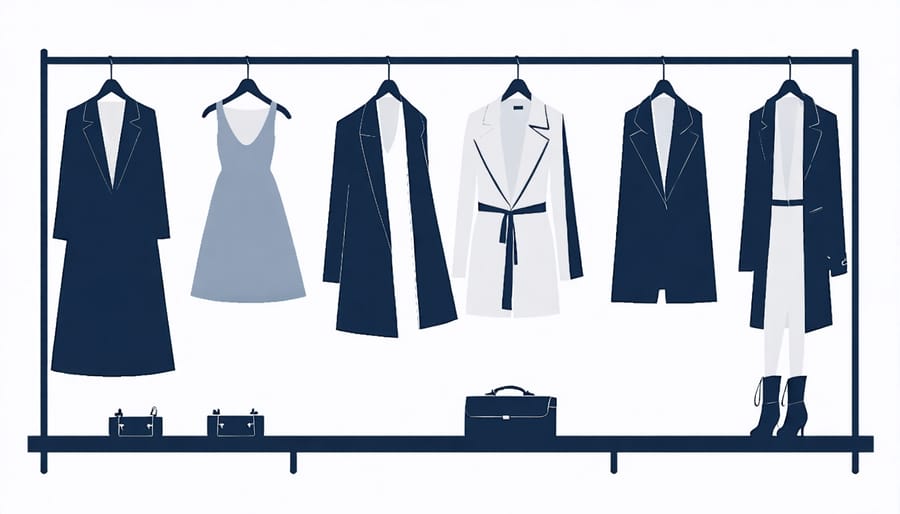
Creating a Capsule Wardrobe
Creating a capsule wardrobe is like building a close-knit family of clothing pieces that work perfectly together while minimizing environmental impact. I remember when I first started my sustainable fashion journey – it felt overwhelming until I broke it down into manageable steps.
Start by auditing your current wardrobe. Lay everything out and ask yourself three questions: Do I wear this regularly? Does it match my timeless style tips? Is it well-made and durable? Keep items that check all three boxes.
Next, identify your core color palette. Choose 2-3 neutral colors (like navy, black, or beige) and 2-3 accent colors that complement your skin tone and personal style. This ensures everything mixes and matches effortlessly.
Focus on these essential pieces:
– 2-3 quality pairs of pants or skirts
– 4-5 versatile tops
– 1-2 well-fitted blazers or jackets
– 1 classic dress
– 2-3 pairs of comfortable, stylish shoes
When adding new pieces, prioritize quality over quantity. Look for natural, sustainable materials like organic cotton, hemp, or Tencel. Consider each item’s versatility – can it be styled at least three different ways?
Remember, building a capsule wardrobe is a journey, not a race. Take time to research brands that align with your values and budget. Second-hand shopping is a fantastic way to find unique pieces while reducing environmental impact. I’ve found some of my favorite items in consignment stores!
Focus on proper care to extend the life of your clothes. Wash in cold water, air dry when possible, and learn basic mending skills. This not only reduces your environmental footprint but also helps maintain your investment pieces.
The beauty of a capsule wardrobe lies in its simplicity – fewer choices, more outfit combinations, and a clearer conscience knowing you’re contributing to a more sustainable fashion future.
As we’ve explored throughout this article, embracing sustainable fashion isn’t just a trend – it’s a meaningful way to express our style while protecting our planet. By making mindful choices about our wardrobes, we can each contribute to a more sustainable future without sacrificing personal style or comfort.
Remember, sustainable fashion is a journey, not a destination. Start small by incorporating a few key pieces into your wardrobe, learning about sustainable materials, and supporting ethical brands. Every conscious purchase, repair, or upcycling project makes a difference.
I’ve seen firsthand how my own sustainable fashion journey has not only reduced my environmental impact but has also helped me develop a more intentional and satisfying relationship with my wardrobe. Many women in our community share similar experiences, finding joy in creating capsule collections and discovering unique, eco-friendly pieces that truly reflect their personal style.
As you move forward, focus on quality over quantity, embrace timeless pieces that transcend seasonal trends, and don’t be afraid to experiment with secondhand fashion or clothing swaps. The future of fashion is sustainable, and together, we’re creating a more conscious and stylish world.
Let’s continue supporting each other in making eco-friendly fashion choices that look good, feel good, and do good for our planet. After all, true style is sustainable.


